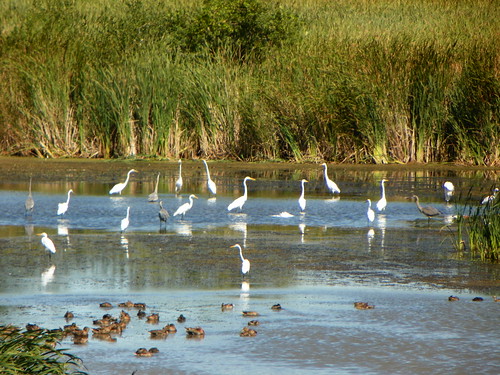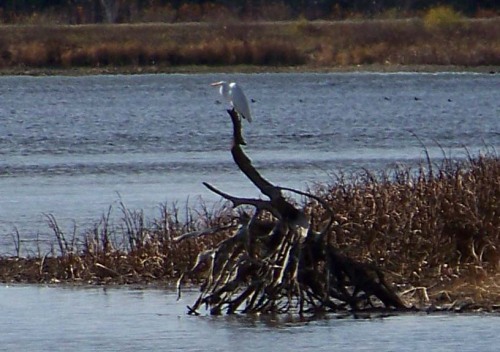
A few egrets…
Posted in Birds, Sunday Snapshot, tagged Great Egret on September 9, 2018| 1 Comment »
Posted in Animal life, Local, tagged Beaver Trail, chipmunk, Great Egret, greenbelt, grey squirrel, hand feeding chickadees, Hiking, National capital commission, nepean, Ottawa, porcupine in tree, Red squirrel, Sarsaparilla trail, wetland, wild bird care centre on September 26, 2011| 4 Comments »

We’ve been enjoying a string of beautiful fall days. I’m not a huge fan of fall, mostly because autumn means winter is around the corner. However, there is no denying that some of the most gorgeous days of the year come along in this shoulder season. On Sunday, it was too nice to stay inside. After getting some chores looked after, we headed up to Nepean, at the edge of Ottawa.

With an inviting array of 100 km of trails, the National Capital Greenbelt offers hikers many choices. Since it was mid-afternoon when we arrived, we explored a couple of the shorter loops. The Sarsaparilla Trail is an easy hike on a level, gravelled pathway. It is just .8 km long, but it proved to be very rewarding.

The trail circles through attractive, open woodland with many beautiful big trees. The Y in this tree was clearly a favorite posing spot for hikers. A large branch was propped up behind the tree so that photo subjects could climb up to the opening.

Near the trailhead, we looked up, way up, and saw two dark shapes in a treetop: two porcupines dreaming in the afternoon sun high above hikers.

Dogs aren’t allowed on the trail and this probably explains the dozens of chipmunks that dart boldly across the trail.

There were also squirrels, both little red squirrels (Tamiasciurus hudsonicus) and their larger cousins, gray squirrels (Sciurus carolinensis). Black squirrels are just a different colour morph of gray squirrels, not a separate species.


About half way around the loop, the trail opens onto a deck overlooking a large wetland.

As we stepped out onto the lookout deck, ducks and geese hurriedly retreated to a safer distance.

We gazed out over the water, admiring the sun sparkling on the surface. At the far side of the swamp, there was a tall white bird, a Great Egret (Ardea alba), not a common species in this region. Cool!

Near the parking lot, was an inviting picnic pavilion. We were struck by how perfect the Sarsaparilla Trail is for introducing young children to nature and hiking. It offers a short, easily traversed trail, plenty of little critters, an interesting lookout over water, and a great place for a picnic.

We had time for another trail, and travelled a short distance to the nearby Beaver Trail loop on Moodie Road. The Wild Bird Care Centre is near the trail parking lot. It is open to the public between noon and 3:00 PM, and an interesting place to visit. For more information, visit their website at Wild Bird Care Centre.org.

Like the Sarsaparilla Trail, the Beaver Trail loops through open woodland and leads to another wetland lookout.

Here and there along the trail were little caches of mixed seed and sunflower seed left behind by visitors. Near the lookout, a family with two youngsters were feeding chickadees. The young girl kindly stood patiently until I was able to get a photograph of one of the chickadees helping himself to a seed from her outstretched hand.

Chickadees and nuthatches were flitting about near the trail, obviously accustomed to handouts. Another time, we’ll take some sunflower seed or peanuts with us. Both these trails had a number of families visiting, which was nice to see.

Posted in Birds, Local, tagged Ardea alba egretta, Atlas of the Breeding Birds of Ontario 2001-2005, Eastern white cedar, Eastern White Pine, Great Egret, moss-covered nest, Pinus strobus, plume trade, Thuja occidentalis, White Egret on November 4, 2009| 2 Comments »

In June, just as the year was springing forward into summer, I visited the Upper Canada Migratory Bird Sanctuary. Now, in the opening days of November, the year is falling back into winter. The trees have mostly lost their leaves and the grasses are turning brown. All that remained of the butterfly population was one lone pale yellow Sulphur and a few Woolly Bears, hurrying across the walkway as they search for a winter home. There was still plenty to see, however.

As RailGuy and I headed down the path, a large bird that we hadn’t noticed took off from the cattails to our left and flew overhead. My first thought was that the bird was a Great Blue Heron. They’re quite common throughout this area. But no! I was excited to see that it was a Great Egret (Ardea alba egretta) These big white birds, just a bit smaller than the herons, are much rarer. Great Egrets have been expanding their range northward, and the Atlas of the Breeding Birds of Ontario 2001-2005 notes that nests found in the Stormont, Dundas, and Glengarry counties area, where the Sanctuary is located, were new sightings, not reported in the previous atlas 20 years earlier.

The egret wasn’t about to stick around for a photography session. I was only able to get a shot from quite a distance. When we walked a bit farther up the path and looked back, we could see that there were two egrets, one wading in the water and one perched on a stump. They may have nested at the Sanctuary this summer. Egrets, like herons, are colonial nesters, so perhaps others were here, or will join them in future years. At the beginning of the 20th century, Great Egrets were hunted almost to the point of extinction for their feathers, which were popular as decorations on hats. The plume trade was very lucrative, and not only egrets but sea birds such as pelicans and terns were hunted. The Audubon Society and other groups were important in raising public awareness, and articles such as “Woman as a Bird Enemy” gradually caused the use of feathers as ornament to fall into disfavour, ending the hunt by World War I.

Farther along the path, this nest was conspicuous in a tree at the edge of a marshy section. It’s builders remain a mystery. Whoever they might have been, they were very skilled.

The ends of the long cattail leaves that were woven into the nest can be seen and the exterior of the nest features a draping of moss.

It was a beautiful day, and we continued along the path as it enters a section of forest. There are many large, attractive trees here, mostly Eastern White Pine (Pinus strobus), with a scattering of Eastern White Cedar (Thuja occidentalis). White pines can be recognized by their long needles, which grow in bundles of five. They are the only 5-needled pine native to eastern North America. White pines are popular plantation trees, but this stand didn’t show the characteristic rows that mark a plantation.

There were a number of fallen trees, their roots laid bare in big discs of soil. I wondered if a changing water table level, due to the flooding for the nearby Seaway, had caused what seemed to be a greater than average number of tumbled trees.

There were plenty of chickadees flitting about in the undergrowth, and some of the pines showed extensive woodpecker activity, including this tall snag. I was surprised it was still standing, considering that so many of its apparently healthier neighbours had fallen.

After admiring the forest, we turned around to head back to the car, passing under this arch formed by yet another listing pine.

We passed by this lodge, which appeared to be abandoned, on the way back. There was evidence of recent beaver activity too, but that’s a subject for another post.
